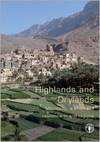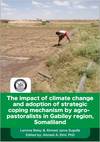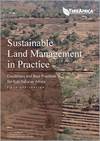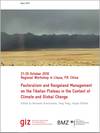Los derechos milenarios de los ganaderos a desplazarse libremente por el territorio nacional fueron reconocidos en 1212 en Aragón por Jaime I, con el Fuero de Pastura universal, y en 1273 en Castilla y León por Alfonso X, con la creación del Concejo de la Mesta. La importancia que adquirió la trashumancia en España es debida a la alternancia de recursos pastables alternativos en invierno y en verano, para lo cual los ganados deben desplazarse frecuentemente a larga distancia, entre 400 y 600 Km, recorriendo las cañadas durante 4 o 6 semanas en primavera y algo más en otoño, al ser las noches más prolongadas. El mayor beneficio se obtenía del comercio de la lana de las ovejas merinas, la más fina del mundo, y que se exportaba a todos los países europeos. Constituyó un preciado monopolio español hasta la invasión napoleónica del siglo XIX.
Year of publication: 2011Organization:
Topic: الخدمات البيئية, الإدراك الفطري, نوع الملكية
Language: Español
Type of document: خرائط
Geographical coverage: أوروبا
Recognizing the crucial role of dryland mountains in implementing a truly sustainable development, the Food and Agriculture Organization of the United Nations (FAO) together with the Mountain Partnership Secretariat, the UNCCD Secretariat, the Centre for Development and Environment of the University of Bern and the Swiss Agency for Development and Cooperation, identified an urgent need to prepare this publication. It provides an overall vision of the ecological, social and cultural features of dryland mountain socio-ecosystems, and aims to demonstrate the importance of investing human and financial resources in dryland mountains ecosystems worldwide in order to limit the impact of global change on the livelihoods and natural resources.
Year of publication: 2011Organization: منظمة الأغذية والزراعة للأمم المتحدة
Topic: تغير المناخ, الخدمات البيئية, الأمور المالية, الشعوب الأصلية, نوع الملكية, مرونة
Language: English
Type of document: تقني
Geographical coverage: مناطق العالم
This publication contains the keynotes and case studies that were presented in the plenary sessions of the regional workshop on pastoralism and rangeland management in the Tibetan Plateau in the context of climate and global change. With this publication, the authors attempt to reach a wider readership that has an interest in the changes, challenges and transformations in pastoralism and rangeland management. Some of the key concepts, designs for modernisation and aims for the immediate future in the rural areas of the Tibetan Plateau are presented here in a concise and easily approachable manner by leading experts in the respective fields.
Year of publication: 2011Organization:
Topic: تغير المناخ, الخدمات البيئية, نوع الملكية, مرونة, القيمة المضافة
Language: English
Type of document: تقني
Geographical coverage: آسيا الوسطى, جنوب آسيا
Despite worldwide coverage of climate change impact, there is inter and intra-sectoral variation in vulnerability depending on location, adaptive capacity and other socioeconomic and environmental factors. In Somaliland, adverse impacts of climate change include recurrent droughts, increased biodiversity loss, species migration and encroachment of invasive plants, increased rural urban migration, changes in the vegetation types, soil fertility loss, and increased infestation of crop by pests and diseases and increased health risks.
This publication presents case-studies documented by Candlelight for Health, Education and Environment, focusing on how climate change is impacting the pastoral communities and environment as a whole in the different ecological zones of Somaliland.
Year of publication: 2011Organization: كتاب مستقلون
Topic: تغير المناخ, مرونة
Language: English
Type of document: تقني
Geographical coverage: شرق أفريقيا
These guidelines for best sustainable land management technologies and approaches are made for practitioners, managers, policymakers, planners, together with financial and technical institutions and donors. They are divided into two main parts. Part 1 highlights the main principles behind sustainable land management, and what considerations are important for technologies and approaches to qualify as ‘best practices’ suitable for upscaling. Part 2 presents twelve groups of sustainable land management technologies as well as a section on sustainable land management approaches. The focus is, in particular, on those practices with rapid payback and profitability and/or other factors that drive adoption.
Year of publication: 2011Organization: منظمة الأغذية والزراعة للأمم المتحدة, ,
Topic: نوع الملكية
Language: English, Français
Type of document: تقني
Geographical coverage: غربية افريقيا, أفريقيا الوسطى, شرق أفريقيا, جنوب أفريقيا
لضفأ تارارق ذاختا نم اونكمتيل كلذو ،يعرلاب ةلصتلما اياضقلا لوح داتعلما مهلمع زكتري لا نيذلا رارقلا عانص ةدعاسلم تاداشرلإا هذه تدِعأ اياضقلا طيسبت لىإ يمرت يهف كلذ عمو ،ينفلا عباطلا وحن تاداشرلإا هذه ةينُب ليتمو .مهتائيبو ينيوعرلا في ةرثؤلما تارماثتسلااو تاسايسلا لوح .ةيقيبطت تايساسأ حبصتل ةيفلاخلا وأ ةدقعلما
Year of publication: 2011Organization: الاتحاد الدولي لحفظ الطبيعة
Topic: اقتصاد, الخدمات البيئية, أمن غذائي, نوع الملكية, منظمة, مشاركة
Language: العربية, 漢語, English, Français, Русский, Español
Type of document: تقني
Geographical coverage: مناطق العالم
"We, the women pastoralists gathered in Mera, India, from November 21-26, 2010, representing 32 countries, have met to strengthen alliances and forward practical solutions to issues that affect us."
"We present this declaration as a guiding political document to inform and support the development of pastoralist policies."
Year of publication: 2010Organization: كتاب مستقلون
Topic: بين الجنسين والشباب, مشاركة
Language: English, Français, Español
Type of document: السياسات والتشريعات
Geographical coverage: مناطق العالم
The regional workshops within the mountain development programme of InWEnt aim at addressing pressing problems of mutual interest among the participating partners by focusing on a specific topic. In 2010 two conferences on pastoralism were held in the framework of the mountain development programme. Complementing the series that started with the Khorog and Kashgar workshops in July the Lhasa gathering happened to be the final part with a special focus on pastoralism and rangeland management on the Tibetan Plateau. It seems to have been the appropriate timing to emphasize upon a pressing issue that is generating increased and rejuvenated interest in the debates on biodiversity, climate and global change. Planners are challenged by designing concepts for nature protection and resource management in order to implement “green policies”. Decision-makers keep in mind the dual challenges between livelihood improvement and natural resource management by translating and transferring it into modernisation programmes. Far-reaching policies that aim at a reconciliation between ecological necessities and economic demands are tested and implemented in a grand design. Especially the Tibetan Plateau is an arena where the term eco-shelter has become a specific meaning that is affecting the reconciliation between nature and society as well as leading to far-reaching transformations in settlement structures and economic strategies. Recent interventions have changed and modified pastoral practices, terminated and extinguished certain traditions and opened-up new hitherto unknown and unexpected opportunities for pastoralists on the Tibetan Plateau. On the vast Tibetan Plateau pastoralism and rangeland management are not only challenges for regional planning, both sectors offer a tremendous economic potential and are proof for the adaptive properties and resilience of pastoralists exposed to harsh environmental conditions and all kinds of changes.
Year of publication: 2010Organization: كتاب مستقلون
Topic: تغير المناخ
Language: English
Type of document: تقني
Geographical coverage: آسيا الوسطى









